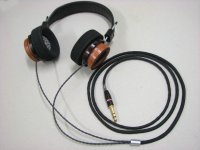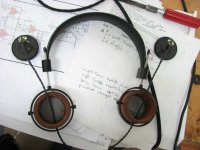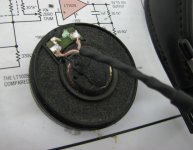this is what they call damping, see the lump of black plasticine/putty. these are vintage MS-Pro that were bought non-functional, the POS cable was busted just inside the ear-cup inside the insulation. I added a bit more dampoing material while I had them open, not much and actually these I didnt mind so much with rock, they did a pretty decent job of 'The White Stripes'
Attachments
Are you able to take every type of distortion apart? I mean... are you able to say "this distorted sound is due to the amplifier, the other one is due to the loudspeaker... and so on"... I don´t think so, at least in the context of this thread 😕Audio enthusiasts have been doing this for decades, except the terminology is different - some translations:
Situation: Low subjective levels of distortion
Indicator Terms: naturalness, palpable, presence, realistic, jump factor, airy, alive
Situation: Significant treble distortion of one type
Indicator Terms: brittle, glare, glassy, hard, metallic, screechy, shrill, steely, strident, grainy, gritty, harsh
Situation: Significant treble distortion of another type
Indicator Terms: dead, dull, muffled, boring, lifeless, uninvolving, closed-in, slow, sluggish
Get the idea ...?
Yes, obvious where it came from ... but pointing out that the audiophile terms are really just classifying, creating signature terms for, various types of distortion ...
I guess (well... I'm sure 😀) it's almost useless to try to discover several types of distortions just by listening to music... the human hearing is not evolved enough to do that and psychoacustics hits against it.
never took them apart, couldn't be bothered as I'm not a headphone freak.this is what they call damping, see the lump of black plasticine/putty. these are vintage MS-Pro that were bought non-functional, the POS cable was busted just inside the ear-cup inside the insulation. I added a bit more dampoing material while I had them open, not much and actually these I didnt mind so much with rock, they did a pretty decent job of 'The White Stripes'
regarding damping, the phones I used to use at work broke so I bought the first pair that seemed to provide the tiniest bit of isolation (~$10). they were simply unusable, what I heard sounded like a lot of high-Q resonances thrown at me. took them apart: large, undamped ABS plastic cavity behind the drivers. took some cotton and experienced with different amounts. I could make them listenable. not audiophile by any standard but nevertheless usable.
maybe that applies to the expensive ones. my SR80s sound practically identical with all amps. true, most of the amps I've tested them with (starting with the cheapest, IC-based headphone out of a vintage CD) are likely low output impedance.
not necessarily, a lot of 'tacked on' headphone outputs, even IC based ones, will have resistors in series with the output to protect the IC from hot-plugging and buffer it from cable capacitance, lots of datasheets called for that sort of thing and actually the cheaper ones are the most likely to be copied directly from the datasheet. Some headphone outputs on old integrated amps will just add resistors to the speaker outputs
headphones used to be much higher impedance in general than today and Grados and Allessandros have always been 28Ω, all of the models, lower than most other headphones historically.
even a lot of personal players have damping resistors on the output for the same reason. its a reaction to this that pretty much started Rocketscientist on his crusade
Last edited:
noted.
one good thing about them. they survived a very short pulse of anode voltage (yes, not a typo) from a tube amp. smelled burnt enamel so I assumed the voice coils shorted. absolutely no change in resistance and the sound is unchanged.
LOL
one good thing about them. they survived a very short pulse of anode voltage (yes, not a typo) from a tube amp. smelled burnt enamel so I assumed the voice coils shorted. absolutely no change in resistance and the sound is unchanged.
LOL
Obviously I'm after "Low subjective levels of distortion", and so if any of those other terms seem to apply to what I'm hearing, then I know I have a problem with the system.Are you able to take every type of distortion apart? I mean... are you able to say "this distorted sound is due to the amplifier, the other one is due to the loudspeaker... and so on"... I don´t think so, at least in the context of this thread 😕
I guess (well... I'm sure 😀) it's almost useless to try to discover several types of distortions just by listening to music... the human hearing is not evolved enough to do that and psychoacustics hits against it.
In my audio adventures prior to CD I was as obsessed as any about the speaker side of things, but a breakthrough in subjective quality occurred for me with the upgrade to digital sound. This pointed out very strongly that the real issues were with the electronics, in the digital source and amplifier, and that's where I've always looked for solutions ever since. Intuition has played a strong part in this, combined with experience, which means I have had good overall success with tracking down the problem areas every time. There is a certain, precise standard of SQ I'm looking for, which I monitor by playing my "worst" recordings; anything beyond that is just extra cream ...
haha, wow, well youve got to give them credit for that!
actually aficionados say that they suit tube amps really well, but I guess thats not the usage case they had in mind 😉
actually aficionados say that they suit tube amps really well, but I guess thats not the usage case they had in mind 😉
whenever I hear anyone raving about huge differences I look at the rest of their system. this made me realize the amount of hype floating around this issue: I'm sure I'd be able to find people who think they hear huge differences between DACs with PC speakers.
Exactly my thought too, it's only with my current speakers I can easily detect differences between my DACs.
maybe one unfortunate day when I will have to move to a place with less understanding neighbors I'll get to try the better models 😀
one thing that has been bugging me.
there's a lot of animosity toward the classic distortion measurements. what I don't get is why isn't anyone trying to come up with alternatives?
one thing that has been bugging me.
there's a lot of animosity toward the classic distortion measurements. what I don't get is why isn't anyone trying to come up with alternatives?
There's lots of alternatives out there going back 50 years or more. They are good enough (as are "classic" methods of spectral analysis) to engineer boxes of gain having no audible signature under ears-only conditions, and can be very useful for evaluating transducers (see, for example the Geddes-Lee papers). Having boxes of gain be accepted in the fashion market has less to do with the distortion metric than it does to the story about the distortion metric.
Where we DO see excellent correlations (beyond frequency response, source impedance, and the like) is measurements like Power Cube, which give superb predictions about amp suitability for particular speakers.
Where we DO see excellent correlations (beyond frequency response, source impedance, and the like) is measurements like Power Cube, which give superb predictions about amp suitability for particular speakers.
can you please give some more info? believe me, I have searched and searched for some meaningful procedures. the Nordost "breakthrough" test does not apply, obviously 🙂There's lots of alternatives out there going back 50 years or more.
I know about the Geddes-Lee metric.They are good enough (as are "classic" methods of spectral analysis) to engineer boxes of gain having no audible signature under ears-only conditions, and can be very useful for evaluating transducers (see, for example the Geddes-Lee papers).
somehow it didn't surprise me, I've given up distortion spectra used as an useful metric for audio quality long ago.
speaking of which. I think the subjectivists try to imply that the "meter readers" think low harmonics = good sound only because of frequency domain auditory masking.
well, I don't.
it's looks to me it's some sort of red herring. distortion spectra are a way of telling how close the output signal is to the input one. including in time-domain. I don't think any person capable valid opinions believes it's about auditory masking only.
well, yes, it's not necessarily the best metric in the context of human hearing. but it is too a metric of time-domain errors.
but to play devil's advocate again, I do believe that the relevant nonlinearities are somehow buried in distortion spectra plots.
I think this is related to what I wrote above 🙂Having boxes of gain be accepted in the fashion market has less to do with the distortion metric than it does to the story about the distortion metric.
didn't Stereophile use to do those kinds of measurements? but not anymore?Where we DO see excellent correlations (beyond frequency response, source impedance, and the like) is measurements like Power Cube, which give superb predictions about amp suitability for particular speakers.
Last edited:
Audio Critic did Power Cube stuff- don't think Stereophile ever did.
Harmonic weighting has a long and honorable history. Gordon Holt wrote about it in the '60s and I think it's even talked about in RDH4. There was an article in Linear Audio Vol 4 by van Maanen which should have some cites on older harmonic weighting schemes, I just don't have a copy with me or I'd tell you what they are. 😀
Harmonic weighting has a long and honorable history. Gordon Holt wrote about it in the '60s and I think it's even talked about in RDH4. There was an article in Linear Audio Vol 4 by van Maanen which should have some cites on older harmonic weighting schemes, I just don't have a copy with me or I'd tell you what they are. 😀
Then there are the equally foolish who are dismissive of good reasoning because it "sounds voodoo". For example, directionality in cables. I always orient my cables according to the text on them. Why? Because that's how, when I assemble them, I terminate the shielding to be "telescoping". Which "end" a shield connects to can have a significant effect on the performance of said shield, I generally find best results when the shield is connected at source, but some people have found them better (for noise performance) connected the other way around, or terminated at one end with a capacitor, or, or, or.....
The point is to be sure that you fully understand what you initially react to as nonsensical, before you dismiss it 100%.
I tend to be more accepting of oddball tweaking than your typical DIY Audio denizen, though naturally some/much of it is true and pure snake oil.
You could just mark the end of the cable with the shield grounded. I assume you're using shielded twisted pair of some kind? I use Canare cable exclusively.
Speaking generally of cables, Mapleshade Audio has some really far out cables:
High Fidelity Speaker Wire
They have "clearview" thin ribbon cables, for example. (even USB?!?! Why? oh, they say the insulation is too thick!)
Mapleshade do make some nice sounding CD's though. Go figure.
shield on an RCA cable? or XLR cable? if the former thats quite curious, as shield and ground are connected and ground is necessarily connected at both ends. personally i'm a no shield, or connected at both ends guy.
I don't think any person capable valid opinions believes it's about auditory masking only.
How can distortion audibility be about anything else?
I meant to correct myself but got caught up in other business. I meant "frequency-domain masking".How can distortion audibility be about anything else?
I'm ~95% sure you knew what I meant 🙂
Shorter (a BBC engineer) suggested a weighted THD metric in 1950. Each harmonic voltage should be multiplied by n^2/4.
shield on an RCA cable? or XLR cable? if the former thats quite curious, as shield and ground are connected and ground is necessarily connected at both ends. personally i'm a no shield, or connected at both ends guy.
It is possible to use shielded twisted pair cable for single ended RCA interconnects. In fact, it makes a lot of sense.
possible, but I disagree it makes sense. there are only 2 terminals on an RCA cable, so whether you connect the shield at both ends of not, the noise current flows back to where it is connected to the ground terminal and by extension a ground wire on the same terminal which IS connected at both ends, thus its connected at both ends, whether you like it or not
Last edited:
- Status
- Not open for further replies.
- Home
- Member Areas
- The Lounge
- Funniest snake oil theories


